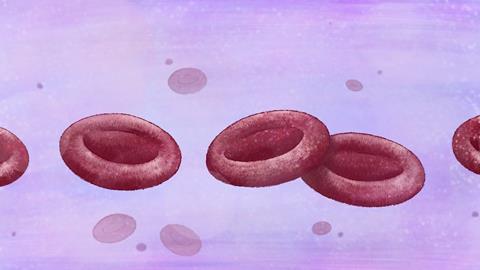Reactivated genes can compensate for other defective genes in hereditary blood disorders, Dutch researchers show in the journal Blood.
Some of the genes in our DNA act as instructions for producing proteins. Errors in these instructions can lead to hereditary diseases, where mutated proteins lose their function. Current gene therapies focus on repairing defective genes by adding new genes or elements from outside the body to remedy this.
However, researchers from the Hubrecht Institute, Erasmus MC and Sanquin have now discovered a new method. They exploited the fact that not all genes are always active, but can also be ‘switched off’. They reactivated helpful but inactive genes by bringing them closer to genetic switches in the DNA known as enhancers. They achieved this by cutting out the intervening piece of DNA with CRISPR-Cas9, a technique they call ‘delete-to-recruit’. Geneticist Wouter de Laat, who recently joined UMC Utrecht, led the research at the Hubrecht Institute. “We have shown that a reactivated gene can take over the function of a defective gene in hereditary blood disorders such as sickle cell disease and beta thalassaemia.”
Reactivation
In patients with sickle cell disease and beta thalassaemia, the adult globin gene is defective. This piece of DNA normally codes for the production of haemoglobin, a protein in red blood cells that is essential for oxygen transport.
However, next to this gene are two foetal genes. These genes are responsible for haemoglobin production during the foetal stage and are then switched off.
A few years ago, researchers demonstrated that an inactive foetal gene could be reactivated by forming a loop in the DNA, thereby reducing the distance between the enhancer and the foetal gene. This enables a cell with a defective adult globin gene to produce globin after all. “I was completely surprised by the fact that this was possible,” says De Laat. ’That inspired us. We are now demonstrating for the first time that this can also be achieved using our ‘delete-to-recruit’ technique, whereby intermediate DNA is removed.”
The reason why the inactive gene is activated by the nearby enhancer is still unclear. Enhancers are known for attracting transcription factors — proteins that promote the transcription of DNA into RNA for the production of new proteins. ‘The classic idea is that a nearby enhancer increases the amount of relevant transcription factors, resulting in more transcription at active genes,’ says De Laat. ‘Inactive genes, on the other hand, are “switched off” by transcription-inhibiting factors. Our results therefore seem to suggest that the transcription-stimulating factors of the nearby enhancer override the transcription-inhibiting factors.”
Stem cells
De Laat’s research group collaborated with Sanquin and Erasmus MC to test their technique in red blood cells. “Sanquin was also interested in bringing gene therapy for sickle cell disease and beta thalassaemia to the clinic,” says De Laat. As an organisation conducting blood research and responsible for the blood supply in the Netherlands, Sanquin supplied primary stem cells from healthy donors. “We wanted to investigate whether our deletion technique could be used for gene therapy in stem cells.”
The researchers succeeded in applying their technique to the stem cells, which then developed into red blood cells that produced foetal globin. This was even more successful than expected. ‘We thought the deletions would be too inefficient to use as a therapy,’ says De Laat. ’But it turned out to work in more than half of the stem cells. The resulting foetal globin production was just as effective as that achieved using other common gene therapies.”
Scaling up
Before the deletion technique can be used as a therapy, CRISPR-Cas9 must be able to successfully edit as many stem cells as possible, according to De Laat. This must be done in a way that keeps them viable. ‘That remains a major challenge.’
In addition to scaling up, safety aspects also remain a barrier. “Obviously, we don’t want the Cas9 protein to cut somewhere it shouldn’t. We need to do more research into the safety of our technique. We estimate that it will take another two to three years before we can offer this as a therapy.”













Nog geen opmerkingen